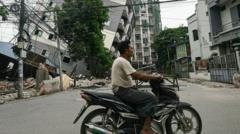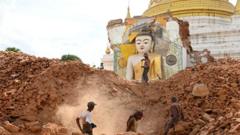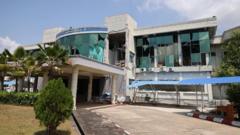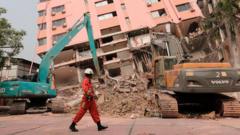A major earthquake measuring 7.7 in magnitude struck Myanmar, claiming thousands of lives and leading to various structural damages across the region. Interestingly, its effects reached Bangkok, over 1,000 kilometers away, causing an under-construction skyscraper to collapse. The geological reasons behind the earthquake and the construction vulnerabilities in the Thai capital are explained in detail.
Myanmar Earthquake's Ripple Effect: Why a Bangkok Building Collapsed
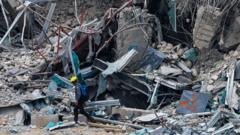
Myanmar Earthquake's Ripple Effect: Why a Bangkok Building Collapsed
A devastating earthquake in Myanmar has resulted in over 1,000 fatalities and triggered unexpected damage as far away as Bangkok, Thailand.
The earth's crust consists of tectonic plates that shift and move, leading to seismic activity. Myanmar, located at the convergence of four tectonic plates, is especially prone to earthquakes, with the recent event occurring along the Sagaing fault. The earthquake’s shallow depth of just 10 kilometers intensified the shaking experienced far from the epicenter. The significant energy released during this 7.7-magnitude quake, exceeding that of the atomic bomb dropped on Hiroshima, traveled along the fault towards Thailand.
Despite Bangkok’s relatively low earthquake risk, the city’s soft soil amplified the seismic waves, heightening ground shaking and resulting in the notable collapse of the unfinished headquarters for the auditor-general's office. While many buildings swayed during the quake, this one succumbed due to its "flat slab" construction method, which lacks sufficient horizontal supports. Although modern building standards exist, the adopted construction style did not comply with seismic safety recommendations.
In contrast, Myanmar's infrastructure faced greater challenges, compounded by general poverty and political instability that impede adherence to building safety codes. Many structures, particularly in Mandalay, were ill-equipped to withstand such earthquakes, exacerbated by the potential for soil liquefaction in vulnerable areas.
Experts warn that ongoing aftershocks pose additional risks to buildings in the region, raising the level of concern for future seismic events.
Despite Bangkok’s relatively low earthquake risk, the city’s soft soil amplified the seismic waves, heightening ground shaking and resulting in the notable collapse of the unfinished headquarters for the auditor-general's office. While many buildings swayed during the quake, this one succumbed due to its "flat slab" construction method, which lacks sufficient horizontal supports. Although modern building standards exist, the adopted construction style did not comply with seismic safety recommendations.
In contrast, Myanmar's infrastructure faced greater challenges, compounded by general poverty and political instability that impede adherence to building safety codes. Many structures, particularly in Mandalay, were ill-equipped to withstand such earthquakes, exacerbated by the potential for soil liquefaction in vulnerable areas.
Experts warn that ongoing aftershocks pose additional risks to buildings in the region, raising the level of concern for future seismic events.




